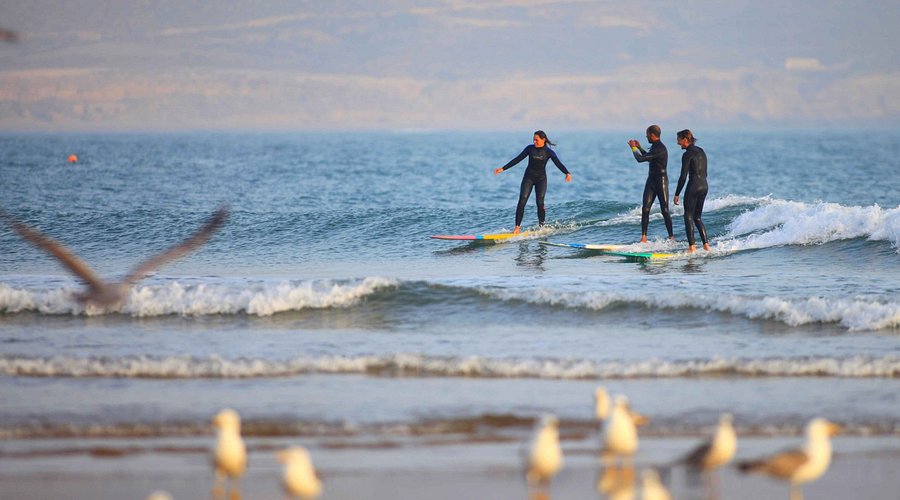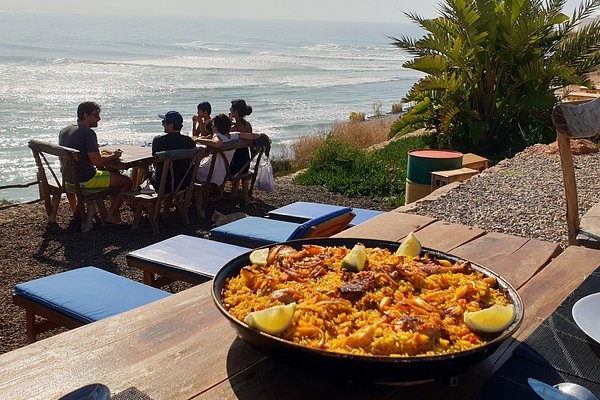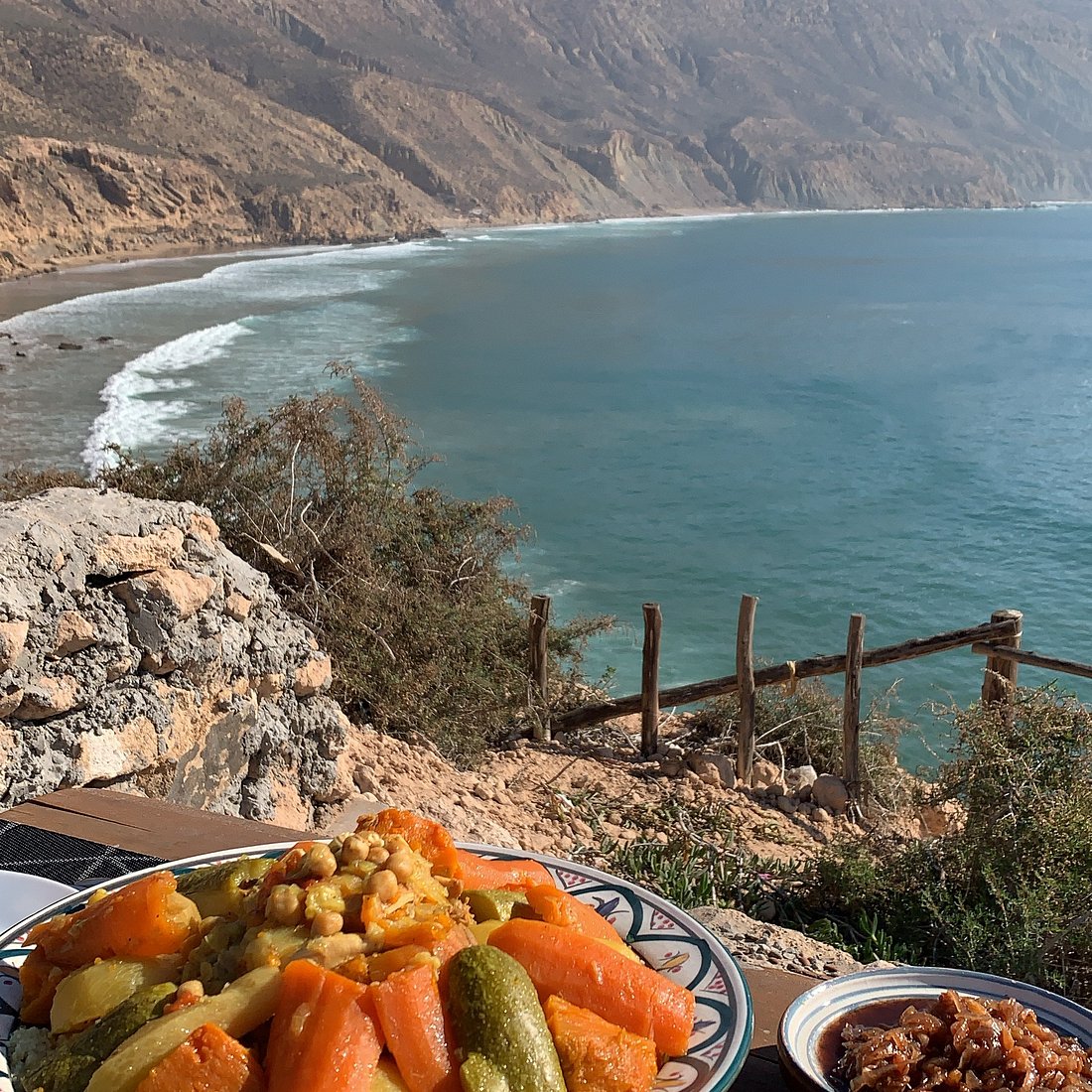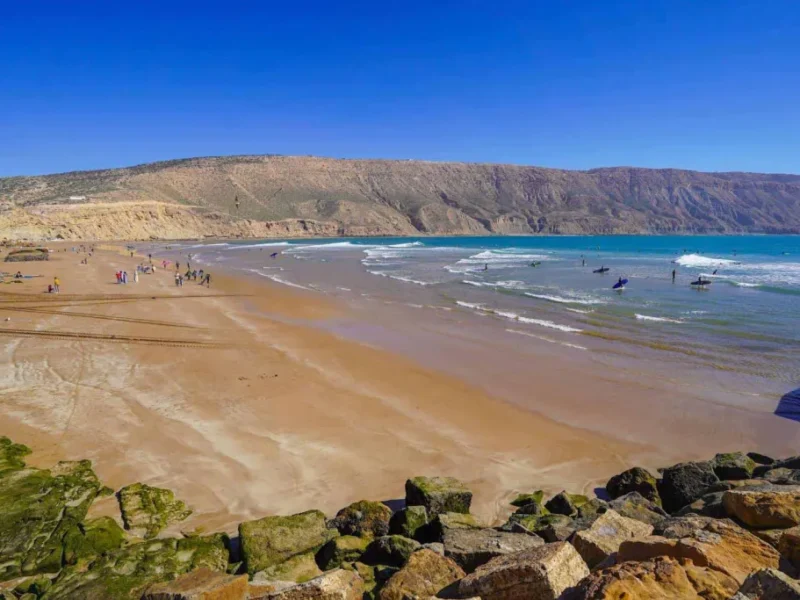What to See in Imsouane: Beaches, Village & Culture – Complete 2025 Guide
Discovering what to see in Imsouane unveils one of Morocco’s most captivating coastal destinations, where pristine Atlantic beaches meet authentic village life and centuries-old Berber culture. This extraordinary fishing village, perched dramatically between towering cliffs and endless ocean horizons, offers visitors an unparalleled glimpse into genuine Moroccan life. From world-renowned surf breaks to traditional fishing harbors, from ancient cultural practices to breathtaking natural landscapes, understanding what to see in Imsouane opens doors to experiences that define authentic Morocco travel.

What to see in Imsouane surfing – perfect wave at the famous Bay break with surfer in crystal clear Atlantic water
The magic of what to see in Imsouane lies in its remarkable preservation of authentic Moroccan coastal culture while embracing sustainable tourism. Unlike heavily developed beach destinations, Imsouane maintains its soul through traditional fishing practices, genuine local hospitality, and pristine natural beauty that photographers and adventurers dream about.
Imsouane’s Spectacular Beaches: Natural Wonders Await
The Main Bay Beach: Morocco’s Surfing Cathedral
The centerpiece of what to see in Imsouane is undoubtedly the main bay beach, home to one of Africa’s most celebrated surf breaks. This crescent-shaped bay creates a natural amphitheater where golden sand meets crystal-clear Atlantic waters, framed by dramatic sandstone cliffs that glow amber during magical sunset hours.
The beach itself stretches over 800 meters of pristine coastline, offering multiple vantage points for observers and participants alike. Early morning visits reveal the bay at its most authentic, with local fishermen launching colorful boats while international surfers paddle out to catch the day’s first waves. This harmonious coexistence between traditional fishing and modern surfing culture exemplifies why what to see in Imsouane captivates travelers seeking authentic experiences.

What to see in Imsouane beaches – pristine coastline with dramatic cliffs and seabirds on golden sand
The beach’s unique geology creates multiple microenvironments perfect for different activities. Protected coves provide calm swimming areas for families, while the main break offers excitement for surf enthusiasts. Tide pools reveal fascinating marine ecosystems during low tide, making beach exploration an educational adventure for visitors curious about Atlantic coastal biology.
Cathedral Beach: Hidden Coastal Paradise
North of the main village lies Cathedral Beach, a secluded stretch of coastline that represents one of what to see in Imsouane’s best-kept secrets. This pristine beach, accessible via a scenic 20-minute walk along coastal paths, offers solitude and spectacular views away from the main tourist areas.
Cathedral Beach earned its name from the dramatic rock formations that create natural arches and chambers reminiscent of Gothic architecture. During low tide, visitors can explore these geological wonders, discovering hidden pools and small caves that shelter diverse marine life. The beach’s isolation makes it perfect for meditation, photography, or simply enjoying Morocco’s stunning coastline in peaceful solitude.
Tamri Beach: Coastal Wilderness Adventure
Twenty kilometers north of Imsouane, Tamri Beach represents wild Morocco at its most spectacular. This expansive stretch of golden sand, backed by the Anti-Atlas Mountains, offers a completely different perspective on what to see in Imsouane’s coastal region.
Tamri’s most famous residents are its wild banana plantations and, during certain seasons, pods of dolphins that play in the surf. The combination of mountain scenery, pristine beaches, and wildlife viewing creates unforgettable experiences for visitors willing to venture beyond Imsouane proper.
Village Life: Authentic Morocco in Daily Rhythm
The Fishing Harbor: Heart of Local Life
Understanding what to see in Imsouane requires experiencing the village’s bustling fishing harbor, where centuries-old maritime traditions continue unchanged despite modern influences. Every morning before dawn, local fishermen prepare their boats for another day harvesting Atlantic waters using techniques passed down through generations.
The harbor comes alive between 6-8 AM when colorful fishing boats return laden with sardines, sea bass, and seasonal catches. This isn’t a tourist attraction but genuine working life where families depend on daily catches for their livelihoods. Respectful visitors can observe boat maintenance, net repair, and the organized chaos of fish sorting and selling.
Local boat builders still craft traditional vessels using time-tested techniques and locally sourced materials. Watching master craftsmen shape wooden hulls and paint intricate designs provides insights into skills that predate Morocco’s modern economy. These boats, painted in bright blues, greens, and reds, create stunning visual contrasts against Imsouane’s dramatic landscape.
Traditional Architecture and Village Layout
The village layout itself represents a significant part of what to see in Imsouane, with traditional Berber architecture adapted for coastal living. Flat-roofed houses built from local stone and rendered with traditional tadelakt plaster create the characteristic appearance that makes Imsouane instantly recognizable.
Narrow alleyways wind between family compounds, leading to hidden courtyards where traditional life continues. Many houses feature rooftop terraces that serve multiple purposes: drying fish, storing equipment, and providing gathering spaces for families during evening hours. These terraces offer spectacular views across the bay, especially during sunset when the entire village glows in golden light.
Village squares serve as community centers where children play football, women gather to share news, and men discuss fishing conditions over endless glasses of mint tea. These social spaces reveal the strong community bonds that define village life and explain why what to see in Imsouane includes such authentic cultural experiences.
Local Markets and Daily Commerce
Weekly markets represent essential elements of what to see in Imsouane, though the village’s small size means most commerce happens in nearby Tamraght or during traveling vendors’ visits. However, small shops and cafés throughout Imsouane provide glimpses into daily economic life and opportunities for genuine cultural interaction.
The village’s single grocery store, run by the same family for over thirty years, stocks everything from basic necessities to fresh produce brought from inland farms. Shopping here means joining local customers, practicing basic Arabic or French, and participating in the social rituals that accompany even simple transactions.
Rich Berber Culture: Living Heritage
Traditional Crafts and Artisan Workshops
Discovering what to see in Imsouane culturally requires exploring traditional crafts maintained by local artisans. While the village itself has limited craft production due to its focus on fishing, nearby communities preserve ancient skills in weaving, pottery, and metalwork.
Women’s cooperatives in surrounding villages welcome visitors to observe traditional textile production. Using hand-operated looms and naturally dyed wool, these artisans create carpets, blankets, and clothing using patterns passed down through generations. Each piece tells stories through symbolic designs that reflect Berber cosmology, family history, and regional identity.
Pottery workshops demonstrate ceramic traditions adapted for coastal living. Local clay, fired in traditional kilns, creates functional and decorative items essential for traditional households. Tagine pots, water vessels, and storage containers reflect both aesthetic sensibilities and practical needs developed over centuries.
Language and Oral Traditions
The linguistic landscape forms a fascinating aspect of what to see in Imsouane culturally. Three languages coexist: Tamazight (Berber), Arabic, and French, each used in different social contexts. Older fishermen often speak primarily Tamazight and Arabic, while younger generations incorporate French and increasingly English.
Evening gatherings still feature traditional storytelling, where village elders share legends, historical accounts, and moral tales passed down orally for generations. These stories, often accompanied by traditional music, preserve cultural knowledge and values while entertaining community members across age groups.
Religious Practices and Community Life
Islamic practices deeply influence daily rhythms and represent important elements of what to see in Imsouane culturally. The village mosque, a simple but beautiful structure overlooking the bay, calls faithful to prayer five times daily, creating natural pauses in community activities.
During Ramadan, the village transforms as families adapt fishing schedules and social patterns to accommodate fasting requirements. Respectful visitors during this holy month can observe increased community solidarity, special evening meals, and spiritual observances that reveal Islam’s profound influence on Moroccan culture.
Religious festivals, particularly Eid celebrations, showcase community unity and traditional practices. Families prepare special foods, children receive gifts, and the entire village participates in communal prayers and celebrations that welcome respectful observers.
Natural Landscapes: Geological Wonders and Coastal Beauty
Dramatic Cliff Formations
The spectacular cliffs surrounding Imsouane represent some of what to see in Imsouane’s most photogenic features. These sandstone formations, carved by millions of years of Atlantic storms, create dramatic backdrops for every village scene while providing excellent hiking opportunities for adventurous visitors.
Multiple clifftop paths offer varying difficulty levels and spectacular viewpoints. The easiest route follows the coastline north from the village, providing access to scenic overlooks perfect for photography and sunset viewing. More challenging paths lead inland to higher elevations with panoramic views extending from the Anti-Atlas Mountains to the endless Atlantic horizon.
Geological diversity creates fascinating rock formations, natural arches, and sea caves accessible during low tide. Amateur geologists find excellent examples of sedimentary rock layers, fossil deposits, and erosion patterns that tell the story of Morocco’s geological evolution.
Argan Forest Ecosystem
Inland from the coastal cliffs, endemic argan forests represent unique ecosystems found nowhere else on Earth. These UNESCO-protected forests form crucial parts of what to see in Imsouane for visitors interested in environmental conservation and traditional resource management.
Argan trees, adapted to Morocco’s semi-arid climate, support traditional economies through oil production while preventing desertification. Women’s cooperatives harvest argan nuts seasonally, processing them using traditional methods to create valuable oil used for cooking and cosmetics.
Forest paths wind through argan groves, providing opportunities to observe native wildlife including Barbary ground squirrels, various bird species, and seasonal wildflowers. Local guides, often shepherds familiar with forest ecology, share knowledge about traditional plant uses, animal behavior, and conservation challenges.
Seasonal Natural Phenomena
Different seasons reveal varying aspects of what to see in Imsouane naturally. Spring brings wildflower blooms that transform surrounding hills into colorful carpets of poppies, daisies, and endemic species found only in this region of Morocco.
Winter storms create spectacular wave displays as Atlantic swells crash against coastal cliffs, producing foam and spray visible from kilometers away. These dramatic weather events, while potentially dangerous, create some of Morocco’s most impressive natural spectacles.
During certain autumn months, migrating birds use Imsouane’s coastline as a rest stop, providing excellent birdwatching opportunities for visitors interested in Moroccan wildlife. Species range from common seabirds to occasional rarities that attract dedicated birdwatchers from across Europe and North Africa.
Cultural Experiences and Local Traditions
Traditional Music and Dance
Evening entertainment represents vibrant aspects of what to see in Imsouane culturally, though experiences depend on building relationships with local families and participating respectfully in community gatherings. Traditional Berber music, featuring drums, flutes, and stringed instruments, accompanies celebrations, religious observances, and seasonal festivals.
Gnawa influences, brought by historical connections to sub-Saharan Africa, appear in some musical traditions. These complex rhythms and spiritual songs create powerful experiences for visitors fortunate enough to witness authentic performances in appropriate cultural contexts.
During wedding celebrations or religious festivals, traditional dances showcase regional variations of Berber cultural expressions. Women’s dances, often performed separately from men’s, feature elaborate traditional costumes and intricate movements that tell stories through gesture and rhythm.
Culinary Traditions and Food Culture
Understanding what to see in Imsouane culturally requires experiencing local food traditions that reflect both coastal geography and Berber heritage. Traditional cooking methods, using tagines and wood-fired ovens, create flavors impossible to replicate with modern equipment.
Fresh seafood dominates local cuisine, prepared using family recipes passed down through generations. Fish tagines, grilled sardines, and seafood couscous showcase the village’s maritime character while incorporating traditional Moroccan spice combinations that create complex, satisfying flavors.

What to see in Imsouane culture – traditional Moroccan seafood tagine with locally caught fish
Bread baking remains a community activity where families take prepared dough to communal ovens operated by village bakers. This daily ritual creates opportunities for social interaction while ensuring everyone has access to fresh bread using traditional recipes and techniques.
Traditional Farming and Land Use
Inland agricultural areas demonstrate traditional farming methods adapted to Morocco’s climate and geography. These practices, maintained for centuries, represent sustainable approaches to food production in challenging environmental conditions.
Terraced hillsides support olive groves, vegetable gardens, and grain crops using irrigation systems developed by Berber communities over millennia. Observing these agricultural landscapes provides insights into traditional knowledge systems and human adaptation to semi-arid environments.
Seasonal farming cycles create varying agricultural activities throughout the year. Spring planting, summer cultivation, and autumn harvests offer different opportunities for visitors interested in traditional agriculture and sustainable farming practices.
Adventure Activities and Outdoor Experiences
Hiking and Coastal Exploration
Physical activities represent exciting aspects of what to see in Imsouane for active travelers. Coastal hiking trails offer varying difficulty levels while providing access to stunning viewpoints and hidden beaches impossible to reach by vehicle.
Popular routes include the clifftop path to Cathedral Beach, offering spectacular ocean views and opportunities to observe seabirds and marine mammals. More challenging inland routes lead through argan forests to traditional Berber villages where hiking becomes cultural immersion.
Local guides, often young men from fishing families seeking supplementary income, provide safe access to remote areas while sharing knowledge about local geography, wildlife, and cultural history. These guides represent authentic cultural exchange opportunities while supporting local economic diversification.
Photography Opportunities
Visual documentation forms a significant part of what to see in Imsouane for photography enthusiasts. The village’s dramatic setting, authentic cultural scenes, and pristine natural beauty create endless opportunities for compelling images.
Golden hour photography, particularly during sunrise and sunset, transforms ordinary scenes into extraordinary compositions. The interplay between traditional architecture, natural landscapes, and daily life activities provides rich subject matter for travel photography.
Respectful cultural photography requires sensitivity and permission when photographing people, especially women and children. Building relationships with local families often leads to more authentic and meaningful photographic opportunities than attempting candid shots of strangers.
Seasonal Variations: What to See Throughout the Year
Spring Season (March-May)
Spring represents optimal periods for discovering what to see in Imsouane across multiple interests. Moderate temperatures, blooming wildflowers, and excellent weather conditions create perfect circumstances for hiking, cultural exploration, and beach activities.
Agricultural activities during spring provide insights into traditional farming cycles as families prepare fields, plant crops, and tend livestock. These seasonal rhythms connect visitors to rural life patterns maintained for generations.
Summer Season (June-August)
Summer brings festival seasons and peak cultural activity, though higher temperatures and tourist crowds can impact authentic experiences. However, longer daylight hours allow more time for exploration and cultural activities.
Traditional celebrations, including religious festivals and seasonal observances, occur more frequently during summer months. Respectful visitors may be invited to participate in community celebrations that showcase traditional music, dance, and food.
Autumn Season (September-November)
Many consider autumn the ideal time for experiencing what to see in Imsouane comprehensively. Perfect weather conditions, harvest activities, and returning surf swells create optimal circumstances for diverse activities.
Argan harvest season provides opportunities to observe traditional cooperative work and oil production methods. Women’s cooperatives welcome visitors during processing seasons, offering insights into sustainable resource management and women’s economic roles.
Winter Season (December-February)
Winter reveals different aspects of what to see in Imsouane as village life adapts to seasonal changes. Fewer tourists mean more authentic cultural experiences and opportunities for genuine local interaction.
Storm watching becomes spectacular entertainment as Atlantic weather systems create dramatic wave displays against coastal cliffs. Indoor cultural activities, including traditional crafts and storytelling, provide intimate glimpses into village winter life.
Conclusion: Embracing Imsouane’s Complete Experience
Understanding what to see in Imsouane reveals a destination that transcends typical tourist categories. This remarkable village offers genuine cultural immersion, spectacular natural beauty, authentic community experiences, and opportunities for meaningful human connection that define transformative travel.
The key to fully appreciating what to see in Imsouane lies in approaching the destination with respect, curiosity, and openness to experiences beyond conventional sightseeing. Visitors who invest time in building relationships, learning about local culture, and participating respectfully in community life discover Morocco’s authentic character while creating memories that last lifetimes.
Every element of what to see in Imsouane – from pristine beaches to traditional fishing culture, from ancient Berber traditions to stunning natural landscapes – contributes to a comprehensive experience that showcases Morocco’s coastal heritage at its finest. The village’s remarkable balance between preserving authenticity and welcoming respectful visitors creates a model for sustainable tourism that benefits both travelers and local communities.
Pack your camera, sense of adventure, and respect for local customs. What to see in Imsouane awaits discovery by travelers seeking authentic Morocco experiences that combine natural beauty, cultural richness, and genuine human connections in one extraordinary coastal paradise.
External Resources:
- Morocco Ministry of Tourism
- UNESCO Argan Biosphere Reserve
- Morocco Beach Guide
- Berber Cultural Heritage Foundation

Comments